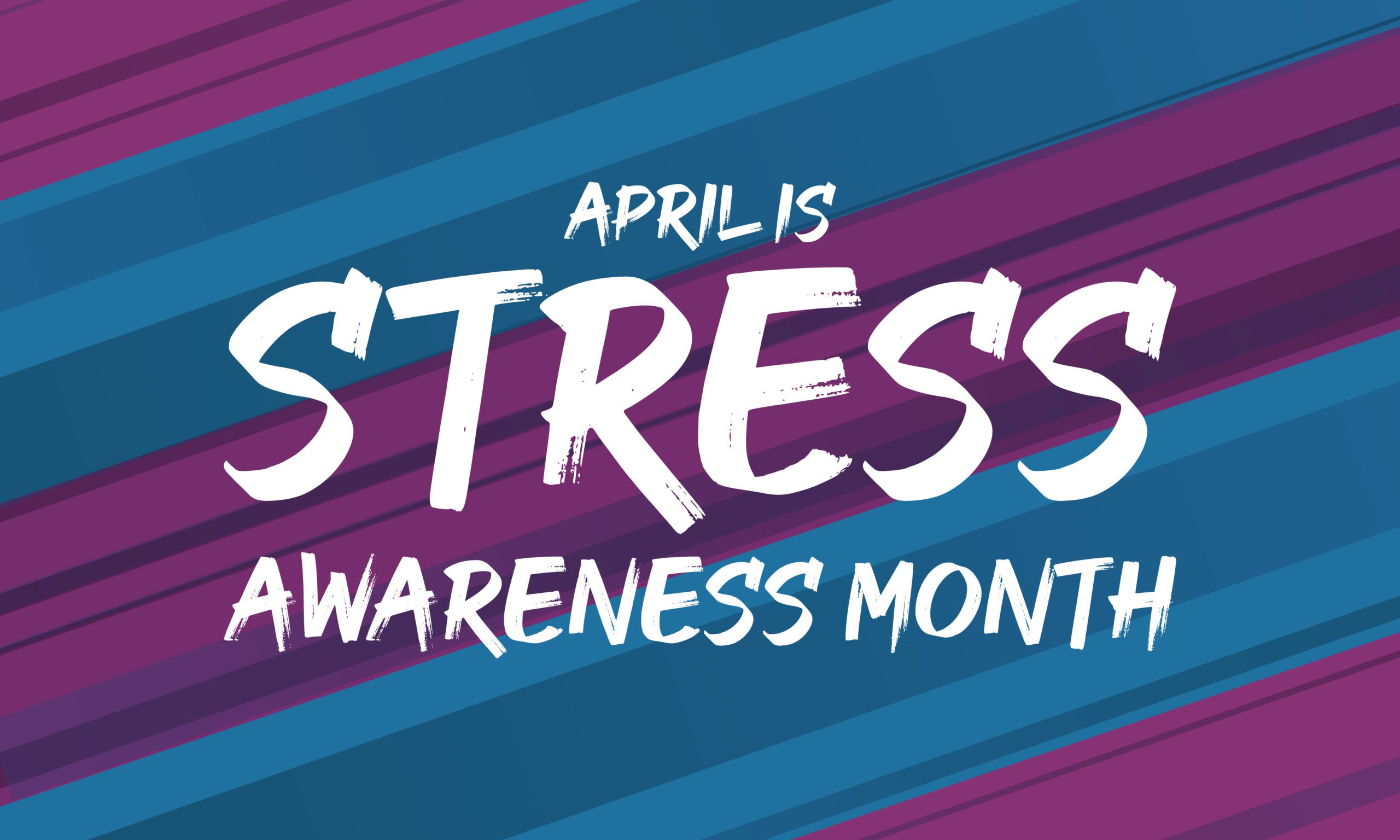By Mary Cortani, U.S. Army Veteran and Founder/Executive Director of Operation Freedom Paws
*This is an article from the Winter 2021-2022 issue of Combat Stress
I am a Veteran who served in the Army from 1975 to1984. When I signed up to serve, I joined the Women’s Army Corps which was absorbed into the Army shortly after my basic training. This was a tough time for women serving, as male troops did not really want us there. I survived and became an MP with a specialization of K9 handler and Army Master Instructor of K9 Education. As my service started at the tail end of the Vietnam War, I am a Vietnam Era Veteran. This was a time of a war within all military branches…and a war that continues today — Military Sexual Trauma (MST).
I am not a clinician or medical professional. I am a Veteran using what I have learned to continue to serve and help Veterans and Non-Veterans (civilians) heal through the use of amazing gifts called service dogs. Not every dog can be a service dog, but those who are change and save lives every day.
Tough Transitions to Civilian Life
Every Veteran goes through a transition when coming out of the military and active duty. It is hard; I did not know how to fit in with non-Veterans. My world was and is black and white, right and wrong, and clear boundaries, just like it is with many other Veterans. Civilian life is filled with gray areas. It took me two years to figure out where I was going to live! Then I had to figure out what I was going to do, how I was going make a living, and survive. I lived with friends and worked 2-3 part-time jobs at the same time. I struggled.
I finally went to school to become an electronic technician, followed by a degree in Computer Engineering. Fast forward to the early 2000’s and I had the rug pulled out from under my feet again. I had worked hard to become an executive in a high-tech company. I was now much older and later in life; the career I had built was suddenly gone. I was let go from a very lucrative position, basically fired for the first time in my life. What was I going to do now? I would have to reinvent myself again.
Finding my Future with Service Dogs
I had never stopped training dogs. In fact, I even did K9 search and rescue throughout the years. It took me a couple of years to figure out that I needed to go back to my passion, training dogs full-time. In 2007 I met a dog that would forever change the course of the rest of my life, CJ (pictured below), my heart dog. So, I decided to start a full-time dog training business (K9 Coach Plus) and became an American Kennel Club Canine Good Citizen (CGC) Evaluator in 2007.
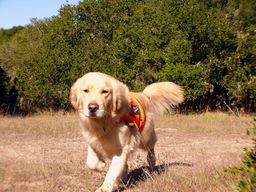
CJ, Mary’s search and rescue buddy and service dog task demo boy.
In 2010, a Marine Veteran with suicidal ideation reached out to me to help him acquire a service dog. He had been on the waiting list of existing organizations for years. I realized I was uniquely positioned to help my fellow Veteran find a rescue dog and teach him how to train a dog to become a service dog, to help him develop the ability to communicate again, and to teach the dog to perform tasks that would help reduce his PTSD symptoms. Hence, Operation Freedom Paws (https://operationfreedompaws.org ) was born out of K9 Coach Plus, and became a nonprofit and my life’s passion.
Operation Freedom Paws: Serving Veterans with PTSD and other Military Traumas
Trying to understand what challenges and injuries face our Veterans sent me on a new journey of learning and understanding. What was Post-Traumatic Stress Disorder (PTSD) and what were the other issues my fellow Veterans were dealing with? Combining my service and civilian training, I made that Marine a promise to help as best I could and that he was not alone.
I founded Operation Freedom Paws after working with that first client. This led to the creation of a 48-week service dog training program based on my knowledge and hands-on experience to serve my fellow Veterans. Operation Freedom Paws became a nonprofit in September 2011. This year we will be celebrating 10 years as a nonprofit, while providing service dogs (83% of which are rescued dogs) and other services to our clients and their families over the last eleven and a half years.
What I have learned throughout those years is that healing doesn’t happen in isolation. PTSD affects families when untreated. It can destroy families and lives. But healing can save families and lives, and the use of a service dog can bridge the gap of family members’ need for understanding of why their loved one is changed.
To date, Operation Freedom Paws has helped over 460 Clients and their families. We have also rescued 380 dogs to be trained as healers for Veterans, first responders and civilians. Our program uses mentor trainers who have graduated from the program. These trainers have become employees who lead classes in our 48-week program. They help each client train a dog assigned to meet the client’s specific medical needs.
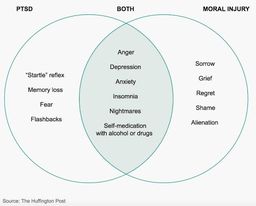
PTSD: An Overview
Post-traumatic stress disorder (PTSD) captured the American public’s consciousness when the American Psychiatric Association added this diagnosis to its Diagnostic and Statistical Manual of Mental Disorders1 after thousands of Vietnam Veterans were identified as having serious mental health problems from their service a decade or more after their return from war. These symptoms were part of a cluster specific to war trauma that include physical (headache, fatigue, sleep problems, dizziness, and sensory sensitivity), cognitive (memory, problems focusing, slowed thinking, trouble putting thoughts into words) and emotional (depression, angry outbursts, personality changes, panic, hopelessness, avoidance) distress.
Moral Injury
Moral injury “involves psychological and spiritual wounds that result from experiences that conflict with one’s deeply held beliefs of right and wrong.”2 In the military, Service Members can experience Moral Injury on the battlefield, such as deep remorse for killing children or witnessing horrific acts of war; in garrison, such as being raped by peers or leaders, or failing to report witnessing harassment/rape of others; or institutional betrayal (by chain of command or government, such as for failures to fix known problems or legitimate grievances). Any of these traumas can have lifetime impact on Veterans. Many Veterans have experienced more than one moral injury and carry deep wounds for their lifetimes. Service Dogs are one of many healing options to alleviate these wounds and help Veterans reconnect to themselves, their families, and their communities.
Traumatic Brain Injury (TBI)
TBI occurs from a sudden blow or jolt to the head. Brain injury often occurs during some type of trauma, such as an accident, blast, or a fall. Often when people refer to TBI, they are mistakenly talking about the symptoms that occur following a TBI. Actually, a TBI is the injury, not the symptoms. TBI’s among Servicemembers and Veterans are one of the signature injuries of the Iraq and Afghanistan wars. They can result in psychological, neurological, and physical needs where a service dog can provide significant help.
How Service Dogs Help Veterans
There is a lack of understanding and a limited body of evidence-based research demonstrating how service dogs can help individuals with invisible wounds and injuries. We are a visual society; what we cannot see we do not believe. Dr. Shauna Springer, Chief Psychologist with The Stella Centers and leading trauma expert, says it best: “even though PTSD is said to be an invisible wound, it is NOT invisible with the right scan.”3 She is referring to high intensity MRI scans that can show brain activity at the micro-level which is not always apparent on older scanning equipment.
While PTSD is evidenced in physiological changes in the brain that can only be seen with such scans, it is my experience that these changes can also be detected by a trained service dog’s nose. Physical changes can be noticed by another person. However, while biological and chemical changes are invisible to the human eye, they are readily perceived by a dog’s nose and observable in the dog’s reactions to those changes. A dog’s keen sense of smell to human and environmental changes has been evidenced in my 45 years of training many kinds of dogs in different capacities, including Sentry, Patrol/Apprehension, Explosive Detection, Narcotics, and Search and Rescue. My understanding from Scent Dog training while in the military is that 60% of a dog’s brain is dedicated to the sense of smell. Dogs can smell at least 10,000 times better than we can.
For example, Diabetic Detection Dogs can smell changes in blood sugar levels in humans, detecting a change in the chemistry of the human body. Our body chemistry also changes with trauma. It changes every time the “fight or flight” reflex kicks in. Dogs can alert the handler/owner to these changes as they are occurring, so that the handler can take action to mitigate the stress accompanying traumatic memories, flashbacks, or nightmares. These alerts are known as service dogs’ tasks.
Dogs communicate with body language. An alert can be a nudge, a wet nose, or a paw that wakes individuals up from nightmares related to their trauma and brings them back to the present. Service dogs lessen anxiety and isolation. A dog can act as the Veteran’s eyes and ears, as well as a gate guard between a Veteran and strangers. These dogs provide safety to allow Veterans to rest and relax. Many of our clients report that they have experienced improved sleep and increased trust in their environment since having their dogs.
When a Veteran enters into a hypervigilant state and becomes agitated, his or her service dog leans in or uses his nose to touch the Veteran’s arm, or touches/licks the hand, effectively saying, “focus on me, I have got you.” Veteran handlers can also train their service dogs to set safe boundaries in public to reduce their stress, enable them to feel safe, and re-engage in their communities. Examples of where service dogs help set boundaries with strangers and in potentially threatening situations include grocery stores, banks, workspaces, social engagements, and restaurants. When a Veteran begins to feel uncomfortable in a situation around someone else, he/she can issue a command to the service dog to “block.” The dog will respond by standing between the Veteran and the perceived threat/approaching individual(s). Here at Operation Freedom Paws we have a list of over 130 commands. Examples of tasks include:
Block, Watch My Back, Post, Pressure, Lap, Find Exit, Get Meds, and Get Help.
Operation Freedom Paws: Trainer/Dog Examples
At Operation Freedom Paws we train each Veteran to train the dog that has been matched with him/her for their specific medical needs. Having Veterans train their dog or puppy gives them a mission, versus being given a dog already trained. By training the dogs themselves, Veterans gain confidence, a sense of purpose, and learn to recognize their own emotions, reduce anger, and become more engaged with family and friends. Similarly, each assigned dog learns specific commands from a single trainer/owner, forms a bond with their Veteran from the beginning of training, and does not have to retrain with the Veteran after being trained by another person. (Some service dog organizations assign dogs already trained, others do not.)
Example 1: Operation Freedom Paws Veteran Service Dog Team, Chau and Apollo. Chau suffers from military service-related PTSD. He has shared with Operation Freedom Paws that being paired with his service dog right before the COVID-19 pandemic saved his life. “Apollo is the light of my life that has pulled me out of the darkness.”
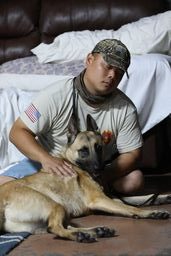
Chau with Apollo (Picture Courtesy of Vicki Topaz
Example 2: Operation Freedom Paws Veteran Service Dog Team, Kim and Artemis. Kim is a frontline healthcare worker who has experienced military service-related PTSD and a confluence of triggers due to the COVID-19 pandemic.
Kim shared, “When I am driving down the road and she steps forward onto the center console and leans against my right shoulder or kisses my cheek, I know she is communicating. She is reminding me to stay present because I am in my head too much.”
When a Veteran with PTSD is experiencing any physical, cognitive, and/or emotional symptoms listed earlier, a service dog can alert and mediate the symptom before it becomes a crisis.
Kim with Artemis, (Picture Courtesy of Vicki Topaz).
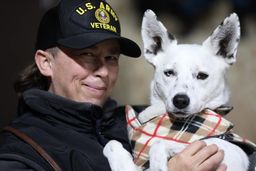
How a Service Dog Helps
A service dog’s alert system works like an early warning detection system for its trainer’s changes in body chemistry. The dog prompts an individual to take action, such as taking medication or implementing coping skills they have been taught in our service dog training program. Service dogs can help Veterans with PTSD, MST, Moral Injury, and/or TBI to re-establish trust with an animal when trust of people has been severely disrupted. Operation Freedom Paws’ clients often come into the program very guarded and non-communicative. When they are matched and start working with their service dogs in training, they learn to trust in the communication between themselves and their dogs, and slowly that trust expands to include people. These dogs help Veterans move toward positive outcomes in their lives. Trauma and broken trust can also be devastating to relationships and families. By establishing new trust with their service dogs, individuals can transform a cycle of trauma into a cycle of healing within their families.
Example 3: Veteran Service Dog Team, Adonis and Smokey. Since graduating from the OFP program, Adonis has started a new job, become a mentor-trainer to new clients in the OFP Certified Service Dog Training Program, and welcomed his daughter into the world.
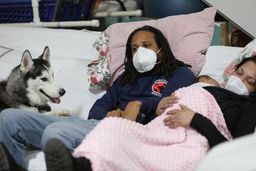
Adonis Family with Smokey (Picture Courtesy of Vicki Topaz)
Research on Service Dogs for PTSD
While research on the effectiveness of service dogs for PTSD is limited, a recent study conducted by VA compared service dog versus emotional support dog pairing in improving the quality of life for Veterans with PTSD.4 This study confirmed the benefits of service dogs over emotional support dogs, and the VA has moved forward in referring Veterans for service dogs and providing some funding for associated costs.
More research needs to be done. Operation Freedom Paws is currently participating in a John Hopkins University research program with seven other service dog organizations. This study is being conducted by Jeremy Ramirez for his doctoral dissertation to determine the effects of service dogs on Veterans with PTSD. We look forward to the results of his study, due out in 2022. We also strongly encourage other researchers to undertake such studies with Veterans with military moral injury, military sexual trauma, and traumatic brain injuries. Such studies will build a body of evidence to expand service dog programs and access within the Veterans Administration, where many Veterans go for their only source of treatment.
OFP Outcome Data, Limitations, and Partnerships
Service dogs are making a real impact on the lives of our Veteran clients with military-connected PTSD. Operation Freedom Paws Post-Program Survey results from a group June 2020 documented significant decreases in suicidal ideation, levels of anger, and amount of medication being taken. The survey, completed by 75 Program graduates, also showed a self-reported increase in the level of communication and quality of life.
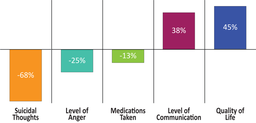
Limitations: Service dogs are just one tool that should be part of a client’s tool belt. A service dog should be used in combination with other treatment modalities such as individual and group therapy, expressive arts therapies, EMDR, and others. There is no one size fits all; service dogs will not work for everyone and should not be the only treatment. Nor are they the magic pill that will cure everything.
OFP is always looking for other services, treatments and tools that complement our program to help our clients on their healing journeys OFP has partnered with The Stella Center and its Chief Psychologist Dr. Shauna Springer, leaders in medical trauma, to advance the healing of individuals with PTSD by combining our healing modalities. According to Stella, PTSD is a biological injury where the response in the brain to an individual’s constant “flight or fight” state can be seen on an MRI.5 The Stellate Ganglion Block (SGB) is a biological treatment that helps to “reset” an individual’s brain and help return it back to its baseline prior to the trauma.6
OFP supports the use of the Stellate Ganglion Block (SGB) as we have had Veteran graduates of our program undergo this treatment with positive outcomes beyond what they have received from their service dogs. The shift to “reset” baseline appears to help restore positive imagery and quiet the internal “noise,” as indicated in the example below.
Example 4: (client with SGB intervention): Adonis, a Veteran client referenced earlier in this article, received the Stellate Ganglion Block (SGB) after completion of our program. Adonis had already become a mentor-trainer and a father before he underwent the Stellate Ganglion Block treatment. He reported that the treatment led to his first positive dream about his military service.
This example illustrates the need for Veterans to find complementary treatment interventions beyond their service dogs in order move them forward toward hope and restoration of positive thoughts and memories. I always advise and encourage our Veteran clients to have their service dogs with them 24/7, while they must pursue other treatments for their military-related traumas.
PTSD Dogs Fall Under Psychiatric Service Dogs
Psychiatric Service Dogs is a broad category describing service dogs that can provide support to individuals with a wide range of mental illnesses, and PTSD dogs are included in this classification. Psychiatric Service Dogs are often cross trained for other physical and cognitive disabilities as well.
Examples of tasks:
- Provide Medication Reminders
- Lay Across Handler to Provide Deep Pressure Therapy During Panic Attacks
- Provide Tactile Grounding via Nuzzling or Licking
- Apply Gentle Teeth Pressure to Forearm to Interrupt Dissociative Episode
- Alert Handler to Episodes of Rage or Strong Emotion
- Interrupt Repetitive Self Harm
- Retrieve Self Care Kit
- Wake Up Handler Having Nightmares
- Interrupt Flashbacks
- Provide “Reality Check” so Handler Can Verify Hallucinations Aren’t Present
- Stabilize Handler’s Routine
- Burrow Under Legs of Handler to Raise Blood Pressure
- Lay Across Chest to Help Handler Clear and Slow Breathing
- Nudge Unconscious Handler into Recovery Position
- Body Block a Dissociated Handler from Going Through Doors
- Help Provide a Physical Anchor
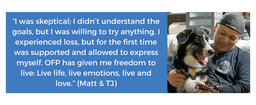
Matt with TJ (Picture Courtesy of Vicki Topaz).
Summary and Recommendations
We have a saying at Operation Freedom Paws that “Training never ever ends.” We tell every client that the path to healing is in the journey; put all the tools in your tool belt that you might need in the future, and not just those you need in the moment. The most valuable tool for many of our graduates is the service dog who accompanies each Veteran on the rest of his/her healing journey. When clients struggle to face their pain and trauma, their service dog can help them. The nose knows; dogs don’t lie.
Recommendation 1: Finding a service dog. Many Veterans and clinicians have no resources for finding a service dog. There are many organizations that train dogs and match Veterans with a service dog, but there is no national accrediting board at this time that certifies organizations. Veterans need to search carefully for an organization that has a history of good “matches” and evidence of positive outcomes, just as the would select a therapist or doctor. For more information on where to find a service dog, readers are directed to contact the Operation Freedom Paws at one of the following emails: [email protected]. or [email protected].
Readers may also reach out to the Association of Service Dog Providers for Military Veterans at (https://servicedogs4vets.org/).
Recommendation 2: Partner with other organizations to publish more research. Research needs funding, a commitment to develop designs with measurable protocols, and subjects willing to participate in research. To move this field forward, we need to develop a body of evidence-based models.
Recommendation 3: Veterans need to ask their local VAs to expand service dog access and funding of service dog nonprofits to provide dogs. Promotion of programs happens from the grassroots level as well as from the top down. Veterans already with service dogs are important partners in promoting access for those waiting for dogs.
References
- Diagnostic and Statistical Manual of Mental Disorders, 5th Ed. (2020). American Psychiatric Association.
- Dart Center for Journalism and Trauma, A Project of Columbia School of Journalism. https://dartcenter.org/content/moral-injury
- Springer, S. (2021). Warrior: How to Support Those Who Protect Us. San Francisco CA: Hidden Ivy Press. https://www.docshaunaspringer.com/
- VA Research: A Randomized Trial of Differential Effectiveness of Service Dog Pairing Versus Emotional Support Dog Pairing to Improve Quality of Life for Veterans with PTSD. March 2021.
- The Stella Center, https://stellacenter.com/
Combat Stress Magazine
Combat Stress magazine is written with our military Service Members, Veterans, first responders, and their families in mind. We want all of our members and guests to find contentment in their lives by learning about stress management and finding what works best for each of them. Stress is unavoidable and comes in many shapes and sizes. It can even be considered a part of who we are. Being in a state of peaceful happiness may seem like a lofty goal but harnessing your stress in a positive way makes it obtainable. Serving in the military or being a police officer, firefighter or paramedic brings unique challenges and some extraordinarily bad days. The American Institute of Stress is dedicated to helping you, our Heroes and their families, cope with and heal your mind and body from the stress associated with your careers and sacrifices.
Subscribe to our FREE magazine for military members, police, firefighters, paramedics, and their families!
ABOUT THE AUTHOR

Mary Cortani joined the Army and was one of the last of the U.S. Army’s WACs (Women’s Army Corps). She served from 1975 to 1984. She became a certified Army Master Instructor of Canine Education while serving in the military.
Mary left the Army, earned her degree in computer engineering, and worked in information technology until 2007 while still training dogs on the side and participating in K9 Search and Rescue. In 2007, Mary started a fulltime dog training business and became an American Kennel Club Certified Canine Good Citizen© Evaluator during this time.
In 2010, Mary was contacted by her first Veteran, who had been on another organization’s service dog waiting list for three years. Since then, she has accepted over 462 clients and their families into the Operation Freedom Paws program and rescued over 386 dogs who needed jobs. Mary has trained sentry, patrol, narcotics, explosive detection, search, and service dogs.
Mary has been training service dogs for over eleven years and has over 45 years of dog training experience. Mary continues as an American Kennel Club K9 Good Citizen Evaluator, and has won numerous awards since 2010, including, the 2012 Top Ten CNN Hero, the Red Cross Clara Barton Award, the Loretta Scott King Award from Martin Luther King Foundation and the KSBW local and national Jefferson Award.



